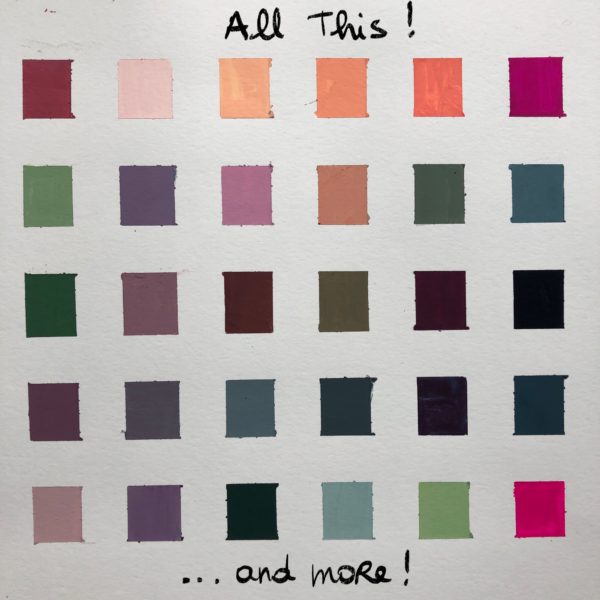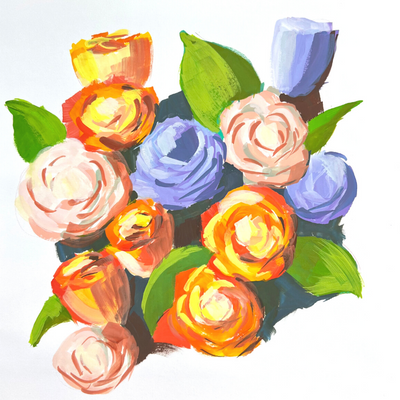Craft Your Perfect Gouache Painting Workspace
Gouache is a versatile opaque water-based paint that has become increasingly popular among artists for its matt finish and bright, intense colors. An optimal workspace setup is crucial to get the most out of gouache and create clean, professional paintings. The proper lighting, surfaces, storage solutions, and tools will make the painting process smooth and enjoyable.
This article provides tips for creating an ideal gouache painting workspace. We’ll cover critical factors like lighting, easels, palettes, brushes, and organization. With the correct setup, you’ll gain more control over your gouache techniques and take your paintings to the next level. The goal is to make your workspace a source of inspiration rather than frustration. Let’s begin exploring how to build your gouache oasis.
Table of Contents
- Lighting
- Workspace Surface
- Easels
- Chairs
- Storage and Organization
- Palettes
- Brushes
- Additional Supplies
- Conclusion
Lighting
Proper lighting is crucial for gouache painting. You’ll want bright, even lighting that accurately represents colors and values in your painting.
There are two main options – natural lighting from windows and skylights or artificial lighting from lamps and fixtures. Many artists prefer natural north light, as it is neutral in color. But artificial lighting can also work well if it provides full spectrum daylight or LED bulbs around 5000-6500K color temperature. Avoid yellowish incandescent lights.
Position your primary light source perpendicular to your workspace. Side lighting from too sharp an angle can create distracting shadows on your work surface and canvas. Diffuse lighting is best. If using a window, situate your painting so the window is on your left if right-handed or right if left-handed.
Supplement your primary light source with a secondary light opposite it to fill in any shadows. Add a task light if working at night or your leading light is not bright enough. Avoid positioning lights directly overhead or behind you, as this can cast shadows over your work. You should also avoid having your light above your hands as it might cast shadows.
With proper lighting, you can accurately judge colors, values, and details as you work. This allows you to mix the intended paints and make the artistic decisions that bring your gouache painting to life. And remember to wait for the gouache to dry before judging value and colors, as you get a shift in value when drying.
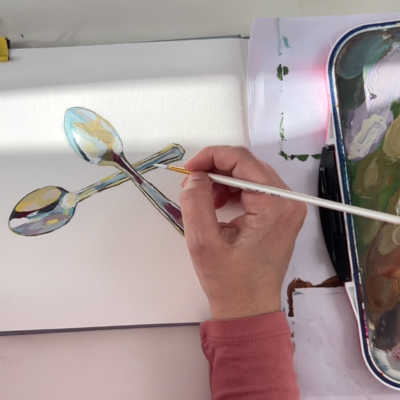
Workspace Surface
As an artist, your desk’s surface can blend functionality, comfort, and inspiration. Consider the following factors when selecting your art workspace surface:
- Wooden desks like oak tables, composite workstations, or craft benches are popular. They offer a rustic aesthetic appeal, and their texture can inspire your creative work. However, be mindful of moisture from the paints as it can affect the wood’s quality over time.
- Glass desks provide a modern, sleek workspace that is also easy to clean. But they might be too slippery for some art supplies, and the potential of scratches could be a concern.
- Plastic or Melamine Workstations are low-cost and easy-to-maintain solutions. They are resistant to stains and offer a smooth surface. You can get kitchen countertops as a cheap solution.
- Paper desk pads are disposable and can be used to protect your workspace surface. Great for doing test swatches or studies, but be cautious of the potential for warping when wet.
- Acrylic Glass Table Tops or Plexiglas can double up as working surfaces and transparent palettes. They are easy to maintain and perfect for tracing due to their transparency. However, their weight (and price!) might be a drawback for some.
Selecting the proper workspace is a personal choice that involves finding a balance between functionality, comfort, cost, and aesthetics. Consider your unique artistic requirements, space constraints, and budget when selecting your perfect art workspace.
Easels
When selecting an easel for gouache painting, you’ll want to consider your space limitations, portability needs, and the sizes of works you intend to create. Gouache easels come in a variety of types:
– Tabletop easels are small and compact, designed for portability and working on smaller paintings. They are easy to set up on any flat surface. Look for tabletop easels with adjustable legs to allow working at different angles.

– Standard studio easels have an H-frame design and adjustable height, tilt, and leg width settings. Studio easels allow working on canvases up to 5 feet tall. But I bet you won’t go that large with gouache, considering the price of tubes. Look for sturdy wooden models with smooth adjustments.
– Floor easels are taller and allow working while standing. Many are collapsible with wheels for portability. Floor easels accommodate large canvases but take up more space.
– Travel easels fold into a compact size for transport and plein air painting. They are quick to set up but less stable than studio easels. Look for aluminum models that will resist rusting.
Consider your space and canvas size needs when selecting a gouache easel. Adjustable studio easels provide the most versatility for most artists. Look for solid construction and smooth adjustability when investing in your easel. Properly supporting your painting surface will lead to better results with gouache.

Chairs
When painting with gouache, having the right chair is crucial for comfort and proper posture. You’ll likely be sitting for extended periods, so your chair needs to provide adequate back support. Here are some features to look for when selecting a chair for gouache painting:
Adjustability: Look for a chair that allows you to adjust the seat height, armrests, and backrest. Fine-tuning the chair to your dimensions and preferences will provide better ergonomic support. Chairs with adjustable tilt tension are also beneficial.
Lumbar support: Proper lumbar support helps maintain the natural curve of your lower spine, preventing back pain and stiffness. Chairs with built-in lumbar support or a separate lumbar cushion are optimal.
Comfortable cushioning: The seat and backrest should be cushioned enough to remain comfortable over hours of sitting. However, too much cushioning can negatively impact support. Look for chairs with firm but comfortable foam or padding.
Breathable fabric: Chairs upholstered in mesh or fabric with an open weave allow for more airflow, keeping you cool during longer painting sessions. Leather or vinyl can get sticky and hot over time.
Mobility: Look for smooth-rolling casters so you can easily move around your workspace. Chairs on a sturdy 5-point base provide the best stability.
Proper seat depth: Your knees should be level or slightly lower than your hips. If the seat is too long, you’ll lack thigh support; if it is too short, the chair will dig into the backs of your legs.
Armrests – Painting with your elbow supported can reduce shoulder and neck strain. Chairs with adjustable armrests allow you to position them perfectly.
Cleanability – when painting with gouache, you may spill some paint on your chair. Having one you can clean with a damp sponge is a good idea, as gouache is washable.
Prioritizing adjustability, lumbar support, and overall comfort will ensure your chair properly supports you during long painting sessions without causing discomfort or poor posture. Investing in the optimal chair leads to better focus and artistic flow. An office chair is a perfect match!
Storage and Organization
Proper storage and staying organized are critical for an optimal gouache painting workspace. Your supplies can quickly become cluttered and chaotic without adequate storage, making it difficult to find what you need when working on a painting. Here are some tips for storage and organization when setting up a workspace for gouache painting:
– Invest in sturdy storage containers, cabinets, shelves, drawer organizers, and racks for art supplies. Look for storage solutions that allow you to neatly organize your paints, brushes, paper, completed works, reference materials, etc. Proper storage keeps everything easily accessible when needed. You can have paid or free options for paint storage.

– Use brush holders, jars, or specialty brush belts to keep brushes organized without damaging bristles. Store cleaned brushes handle-down or horizontally.
– Designate drawers or shelves just for paper storage to keep sheets and pads free of damage. Consider upright paper racks for easy access to paper options.
– Label storage areas and containers to find what you need quickly. Group like supplies together.
– Maintain clutter-free surfaces for your easel, palettes, and active painting area so you have ample working room. Return supplies to their storage spots after painting sessions.
– Store reference materials, sketches, finished paintings, and other documents in portfolios, folders, tubes, shelves, or drawers.
– Clean brushes and other supplies after each session so your workspace is ready for your next painting session.
Staying organized is an ongoing process, but storing supplies properly will make your painting experience much more enjoyable and productive. Aim for a workspace that inspires you to create.
Palettes
When painting with gouache, having a palette to mix and hold your paint is essential. There are a few key considerations when selecting a palette:
Disposable vs. Reusable
– Disposable palettes like paper or plastic plates are inexpensive and easy to replace between painting sessions. Although it’s not environmentally friendly, this can help keep your colors clean.
– Reusable palettes made of wood, ceramic, glass, or metal allow you to clean and reuse them. This creates less waste but requires more cleaning between sessions.
Palette Types
– Open palettes like ceramic plates or wood painting boards allow you to load multiple paint colors directly on the surface. This works well for mixing large amounts of color.
– Palettes with wells or slanted mixing areas keep each color contained and prevent mixing. The wells should be large enough to load adequate paint.
– Watercolor palettes with a central mixing area and smaller outer wells provide space to mix paint and keep colors separate.
Having the right palette will make your gouache painting experience much more efficient and enjoyable! Test out different options to find your optimal palette preferences.
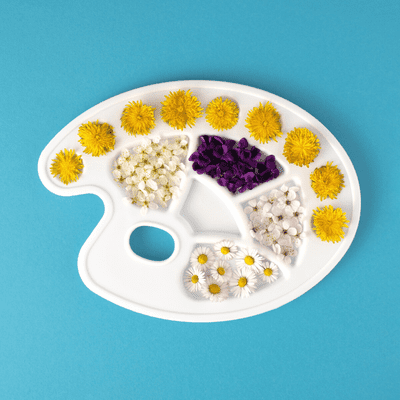
Brushes
Brushes are a critical tool for any gouache painter. The type and size of brush you use can dramatically affect the look and feel of your painting. Here are some tips on selecting and caring for gouache brushes:
Recommended Brush Types and Sizes
– Rounds are versatile brushes that can create fine details and broad strokes. Good starter sizes are #4, #6, and #8 rounds.
– Flats – Flats have a rectangular ferrule and can make flat, even strokes. These are ideal for large areas of color. Try #4, #6, and #10 flats.
– Riggers – Rigger brushes have very long bristles and can make continuous lines. Use them for details like branches, grass, or hair. #0 and #1 riggers are commonly used.
– Fans – Fans have a spread-out edge and can lightly blend or soften edges. #4 or #6 fans are a nice addition.
Aim for a variety of shapes and sizes for different effects. It’s better to start with a few brushes than a huge set.
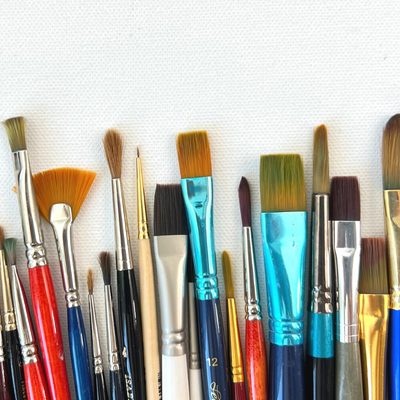
Proper Brush Care and Cleaning
– Rinse brushes thoroughly after each use to remove gouache and prevent permanent staining. Gently massage water through the bristles.
– Shake out excess water and reshape the bristles before storing. Let brushes fully dry with the bristles facing up.
– Clean with mild soap and water if brushes get very stained. Avoid harsh solvents that could damage the bristles and are unnecessary for gouache paint.
– Store brushes handle-down in a cup, jar, or brush holder to maintain shape.
– Check for stray hairs and gently remove them so they don’t pull out clumps while painting.
With proper selection and care, your gouache brushes will last for many great paintings!
Additional Supplies
While you may already have basic painting supplies like water containers, paper towels, etc., gouache painting does require some specialized additional supplies that are good to have. These optional extras can make your painting process easier and more efficient.
– Spray bottles – Having a spray bottle on hand to lightly mist your paints is helpful for reactivating gouache that’s started to dry on the palette. Aim for a fine, controllable mist.
– Paper towels – Paper towels are helpful for quickly dabbing spilled water, wiping off dirty brushes, and cleaning tasks. Stock up on a multi-pack of soft paper towels.
– Cleaning supplies – It’s ideal to have gentle cleaning products like dish soap, brush cleaner, and surface wipes to maintain your painting tools and workspace. Don’t use harsh chemicals that could damage brushes.
– Airtight palette – While not required, a specialty palette with a sealable lid helps keep gouache paints usable for longer before drying out.
– Painting clips – These helpful clips securely attach your paper or canvas board to your easel surface, preventing buckling or shifting while working.
Having the right additional supplies on hand makes gouache painting more efficient, convenient, and mess-free!
Conclusion
Creating an optimal workspace setup for gouache painting requires initial planning and organizing but is worth the effort. A proper setup allows you to focus on the joy of painting rather than struggling with a cluttered or uncomfortable workspace.
In summary, the key tips covered in this article include proper lighting from natural light or an adjustable lamp, a sturdy horizontal surface like a table or desktop to work on, an easel for canvas or paper painting support, a comfortable chair at the right height, storage solutions for paints, brushes, and other supplies, a palette for mixing paints, high-quality brushes suited for gouache, and any additional items like paper towels, water containers, or artwork references handy.
With these simple optimizations to your gouache painting area, you’ll gain the following benefits:
– Better visibility of your work surface and painting with adequate lighting
– Ease of access to paints, brushes, paper, and other supplies
– Freedom of movement without clutter getting in the way
– Reduced fatigue by working at a proper table height on a comfy chair
– Organization to find what you need quickly and keep focused on painting
– Confidence your paper or canvas is securely supported on an easel
– Cleanliness to prevent messes and damage to your space
The preparation may seem daunting, but approach it step-by-step. Start with essential elements like lighting and the workspace surface, then gradually make changes like storage solutions, painting tools, and furniture. Before you know it, you’ll have the ideal painting haven to unleash your creativity.
Set yourself up for painting success by optimizing your gouache workspace. Your future masterpieces will thank you.







